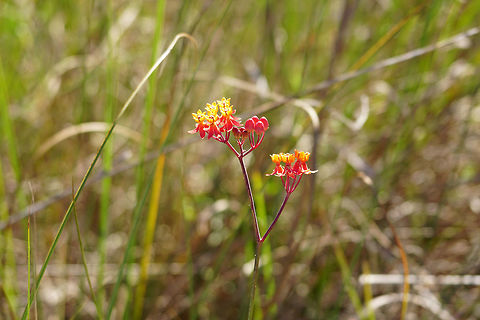
Appearance
Individuals of this species grow upright to a height between 3 and 5 feet in an herb growth pattern. Leaves are oppositely arranged and are lanceolate shaped with an acuminate apex. The leaves can grow to 10 cm in length. The stem branches near the top to form 1 to 3 umbels, each containing an average of seven red-orange flowers. Most members of the ''Asclepias'' genus have more flowers than seen in this species, hence its common name fewflower milkweed. During the winter months, this plant is completely deciduous and barely noticeable when not flowering.Distribution
''Asclepias lanceolata'' is found on the coastal plains of Eastern and Southeastern United States. Populations of this milkweed are found in the following states: Alabama, Delaware, Florida, Georgia, Louisiana, Maryland, Mississippi, North Carolina, New Jersey, South Carolina, Tennessee, Texas, and Virginia. It is distributed throughout most of Florida but only found in small areas of southeast Texas. Further details on state county distributions can be found on the USDA's for this species. ''A. lanceolata'' is on display at the Crosby Arboretum in Picayune, Mississippi.Habitat
Fewflower milkweed is a perennial plant that can be frequently found in marshes , low glades, and wet pine barrens. It prefers sandy and loamy soils that are well-drained, but can also survive in poorly drained swampy soils. Optimum soil pH is between 5 and 7, however it can grow within a range of 4.5 to 7.5. While it can grow in semi-shaded areas, it prefers a sunny site. ''A. lanceolata'' is adapted to a precipitation zone that ranges from 500 to 1500 mm annually, and a temperature that ranges from 8 to 35 degrees Celsius. Optimum precipitation range is 600 to 1400 mm per year, and optimum temperate ranges from 12 to 30 degrees Celsius. This milkweed can withstand winter temperatures down to -25 degrees Celsius. In the wild, it is often found growing near Salt Marsh Mallow, ''Kosteletzkya virginica''. This plant is susceptible to damage by slugs, especially when it is young and vulnerable.Food
It is important to take precautions when eating these plants, as milkweeds have been known to be poisonous to humans. While there have been no report of toxins in ''Asclepias lanceolata'', many milkweeds do contain toxic resinoids, alkaloids, and cardiac glycosides. The flowers, leaves, and young seedpods of this species have been deemed safe for consumption. Seedpods should be eaten when they are between 3 and 4 cm long; their alkalinity and bitterness increases as they grow larger. Plant parts, especially stems and mature leaves, should be boiled with three changes of water to remove any possible toxins. Younger leaves, pods, and unopened flower buds can be cooked just as one would prepare spinach or broccoli. Once cooked, parts of the plant can be eaten on their own or mixed into other things such as soups. Boiling down the flower clusters containing nectar can make a sugary sweetener.References:
Some text fragments are auto parsed from Wikipedia.